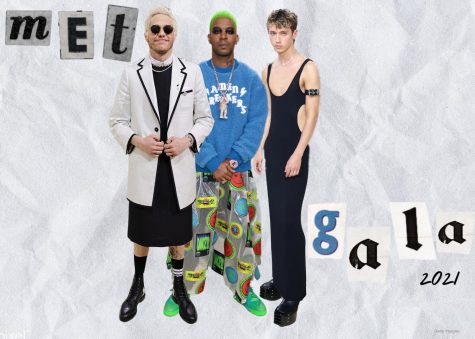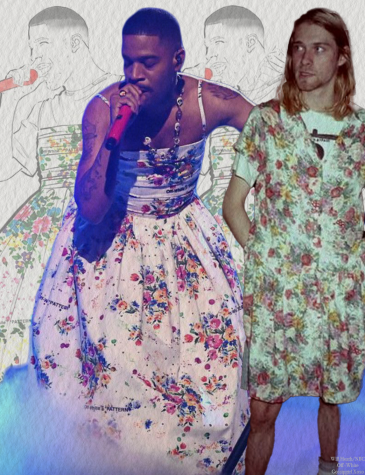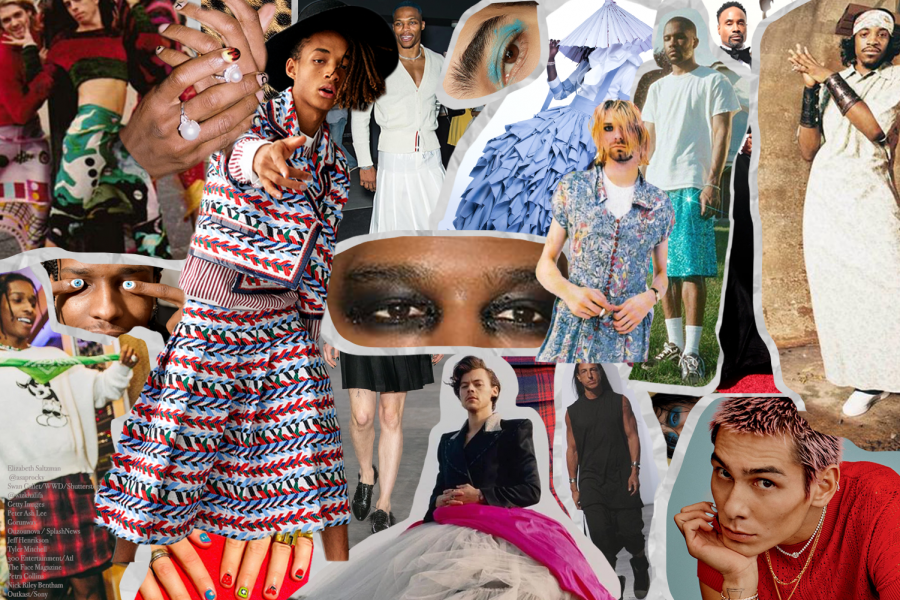What makes a man? His actions, mannerisms, clothing?
With the floods of appraisal and awe of ex-One Direction member Harry Styles featured on a Vogue cover earlier this year, sporting a periwinkle tulle lace dress with black lace detailing, many have stirred up controversy.
“Bring back manly men,” a remark made by a conservative party activist, Candace Owens, responding to Vogue’s tweet featuring Styles. Pictures of more masculine men wearing suits with abrasive captions like “what happened to men looking like this to be handsome” were left on the artist’s post.
Men have modeled feminine clothing for hundreds of years. Roman men dressed in elegant flowy togas, white wool robes, the Middles Ages men dressed in flamboyant puffy skirts that were similar to women’s skirts, and in the mid-1980s, high-end men’s fashion stores started designing skirts for men. It is a fashion trend that has been repeated throughout history, and some have even argued that it is more practical for men, yet so taboo and controversial today.
One particular spectacle of people that have taken a stab at defying today’s societal gender non-conformity is musical artists. Styles, Jaden Smith, Young Thug, Kanye West, Andre 3000, A$ap Rocky, and Kid Cudi are just a few of the many celebrity figures that have willingly taken the bold risk.
“In five years when a kid goes to school wearing a skirt, he won’t get beat up, and kids won’t get mad at him,” musician and actor Jaden Smith said in a 2016 campaign for Louis Vuitton. “It was lit because we all knew that we were going to impact the culture and change the game and make a difference.”
Smith was one of the first celebrities that has advocated for men in skirts and dresses since the 2010s, most known for his campaign for Louis Vuitton’s womenswear.
Seeing the progress from Smith’s statement, five years ago, men in skirts and dresses are now becoming more recognized. This year’s annual Met Gala, an event for celebrities and designers to showcase their wildest and most creative outfits, multiple male-identifying celebs, both straight and gay, sported skirts and dresses.

Troye Sivan, an Australian pop singer, wore a stunning, shaped, black dress designed by Altu. Pete Davidson showcased a black layered dress designed by Thom Browne.
Britt Theodora, Davidon’s stylist, said, “We felt the dress represented Thom Browne’s identity as an American designer who is constantly breaking boundaries and norms,” in an interview with Vogue regarding Davidson’s 2021 Met Gala look. Kid Cudi, a famous rapper who has worked with people like Kanye West, also joined this revolution wearing a Louis Vuitton patterned skirt and emo-inspired eye makeup to the Met.
This isn’t Cudi’s first appearance in a dress, as he wore a long floral dress during his performance as a guest on an “SNL” episode back in June of this year. The floral dress, designed by Louis Vuitton and Off-White streetwear designer and creator Virgil Abloh, was tailored in homage to the anniversary of singer Kurt Cobain’s death.

Cudi, taking after the late singer and band member of Nirvana, Kurt Cobain, was known for wearing dresses and defying gender norms back in the 1990s. Besides his musical feats, Cobain was well known in rock culture for defying gender norms, advocating for women’s rights, and experimenting with feminine clothing and makeup. Cobain was very comfortable with his masculinity and didn’t care about the criticism it came with.
“There’s nothing more comfortable than a cozy flower pattern,” Cobain said, responding to the iconic floral dress he wore during one of his performances.
Kid Cudi and Jaden Smith aren’t the only hip-hop artists that have not been afraid to express their more feminine side. Young Thug on his album cover, Jeffery, wore a long, textured blue dress and an oversized sunhat. Thug is very open about his gender and says, “I feel like there is no such thing as gender,” In a campaign with Calvin Klein.
Thug faced another issue other than being ridiculed on the internet that other celebrity men who were vocal in their masculinity’s comfortability did as well. Many speculated that these men are only doing it for the attention and an attempt to remain relevant in their careers, according to a podcast interview with Young Thug about the dress we wore on his album cover.
“I think that they’re (Billy Porter and Jaden Smith wearing skirts and dresses) sort of expanding the ideas of masculinity,” said Myles Lascity, a professor of fashion and media at SMU. “Obviously, there is a business component to that, but I’d be hesitant to say that it’s all a publicity stunt.”
The theory of attention-seeking motives about these men fuel the speculation on the meaning of their bold clothing choices. Blindsighted by the history of men’s apparel, many people still think more feminine clothing choices make them “gay,” “transgender,” or “desperate attention seekers.”
“I just liked how it [painting his nails] looked. I didn’t think of how feminine or masculine it was,” says junior Joe Matatyaou. “I think people should be able to wear whatever they want if it makes them happy.”
The mission to many celebrity men expressing the comfortability of their masculinity is to bend gender norms and experiment. They want to prove that dressing a certain way doesn’t always correlate to someone’s gender or sexuality; they don’t care if people label them based on their clothing choices; they want to expand on men’s clothing and normalize clothes as non-binary.
“The way (societal) fashion embodies sexuality and the ideas of masculinity are bound up and restricting,” said Lascity.
Wearing more feminine clothes has caused many to ponder the sexuality of the person concerning their clothing choices, with the rare sightings of men in dresses and skirts every day in fear of being judged or labeled. The ideals of being “masculine and straight” aren’t lined up with wearing feminine clothing in modern-day society. The narrative that many celebrities discussed that are trying to combat.
“If you can comprehend that these traits, masculinity, and femininity, are not restrictions or determining factors of one’s gender and rather exploration and celebration of freewill and expression of self — you are not only understanding why a ‘male-presenting person is wearing a dress,’ but achieving growth towards society as a whole,” said Abloh, the designer of Kid Cudi’s “SNL” dress said.












